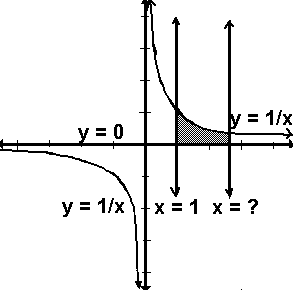 2 for y values.
2 for y values.

The doubling function, for example, is a power function.
Use the rule: y = 2x. Use values of 1, 2, 3, and 1/2 for x and
get corresponding values of 2, 4, 8, and
 2 for y values.
2 for y values.
Examine the "Family of Exponentials Graphs" to see how different y = 1x behaves relative to y = 1.5x, y = 2x, y = ex. For every value of x, 1x is 1, so the function is constant, there is no growth.
For all bases greater than 1, there is ALWAYS GROWTH, as x increases.
For all bases between 0 and 1, there is ALWAYS DECAY as x increases.
For positive values of x, the larger the base, 1.5 versus 2, versus e, the larger the value of the function, y = 1.5x, y = 2x, y = ex, and therefore the steeper the curve, the faster the growth: The larger the base, the faster the growth.
For negative values of x, the smaller the base, 1.5 versus 2, versus e, the larger the value of the function, y = 1.5x, y = 2x, y = ex, the and the steeper the curve, and the faster the growth: For negative values of x, the smaller the base, the faster the growth.
The slope of y = bx is bx(ln b).
The inverse function for y = bx is y = logb x.
Power or exponential functions are powerful tools. They are used to express growth and decay. They are used to express other function such as:
|
On ex & e |
The numbers 0, 1, -1, , e, and i are celebrates among numbers. They are
no different than other more common numbers, but are "more famous" and very useful and
important. The numbers , 0, 1, and -1 are probably familiar to you. The
complex number
i is the square
root of negative one,
 -1. It solves the equation x² = -1 with solutions of i and -i.
-1. It solves the equation x² = -1 with solutions of i and -i.
The number e is about equal to 2.71828 but this does not explain what number it is. It also may be said to solve an equation. One definition of e involves the solution of a calculus equation involving an integration, an antiderivative, the inverse of finding the slope. Here's the equation:


Consider the graph of the horizontal line y = 0 as a bottom boundary line. Use the vertical line x = 1 as a left boundary line, and the reciprocal function as a top boundary line. A four-sided shape would be created if a vertical line were drawn on the right. The vertical line which creates a shape having an area of one is the vertical line x = e. Suppose the integral of the reciprocal from 1 to some upper limit equals one. That upper limit is e. The number e solves the equation below where the upper limit b is the value being sought.
You may experiment with this yourself. Find the upper limit, the value that
makes the equation equal to 1.
Ok, so what's the big deal?
Slope. The exponential function, because of its base e, has the only slope that is the same as the function! The derivative is the same as the function and its integral is also the same as the function, because the base is e.
Read: Even More About e, the base of the Natural Logs and on Parent Functions, Their Slope Functions, and Area Functions, more still about e.

The exponential function is a power function having a base of e. This function takes the number x and uses it as the exponent of e. For values of 0, 1, and 2, the values of the function are 1, e or about 2.71828, and e² or about 7.389056.
The exponential function is its own slope function: the slope of e-to-the-x is e-to-the-x. The inverse of ex is ln x, which is loge x, the natural logarithm of x.
Many things are expressed in exponential notation.
Growth of the population of people or a disease as well as the decay of a radioactive isotope are
expressed in exponential terms. Interest, as in loans or bank balances, if compounded continuously
is expressed as a power of e. The true statement e
 i - 1 = 0 relates the famous numbers mentioned earlier.
Exp(x) or ex may be computed to desired accuracy knowing that ex =
1 + x + x2/2! + x3/3! + x4/4! + ...
i - 1 = 0 relates the famous numbers mentioned earlier.
Exp(x) or ex may be computed to desired accuracy knowing that ex =
1 + x + x2/2! + x3/3! + x4/4! + ...
This page is from Exploring Functions Throught the Use of Manipulatives (ISBN: 0-9623593-3-5).
You are hereby granted permission to make ONE printed copy of this page and its picture(s) for your PERSONAL and not-for-profit use. YOU MAY NOT MAKE ANY ADDITIONAL COPIES OF THIS PAGE, ITS PICTURE(S), ITS SOUND CLIP(S), OR ITS ANIMATED GIFS WITHOUT PERMISSION.
 | ![[MC,i. Home]](http://www.mathnstuff.com/math/spoken/here/1gif/mcihome.gif)
![[Table]](http://www.mathnstuff.com/math/spoken/here/1gif/table.gif)
![[Words]](http://www.mathnstuff.com/math/spoken/here/1gif/words.gif)

![[this semester's schedule w/links]](http://www.mathnstuff.com/gif/semestr.gif)
![[Good Stuff -- free & valuable resources]](http://www.mathnstuff.com/gif/goods.gif)
![[next]](http://www.mathnstuff.com/math/spoken/here/1gif/next.gif)
![[last]](http://www.mathnstuff.com/math/spoken/here/1gif/last.gif)
© 2018, 2019, 2024, Agnes Azzolino www.mathnstuff.com/math/spoken/here/2class/300/fx/library/expofx.htm |